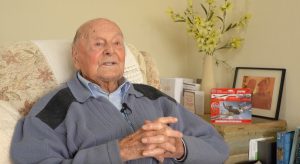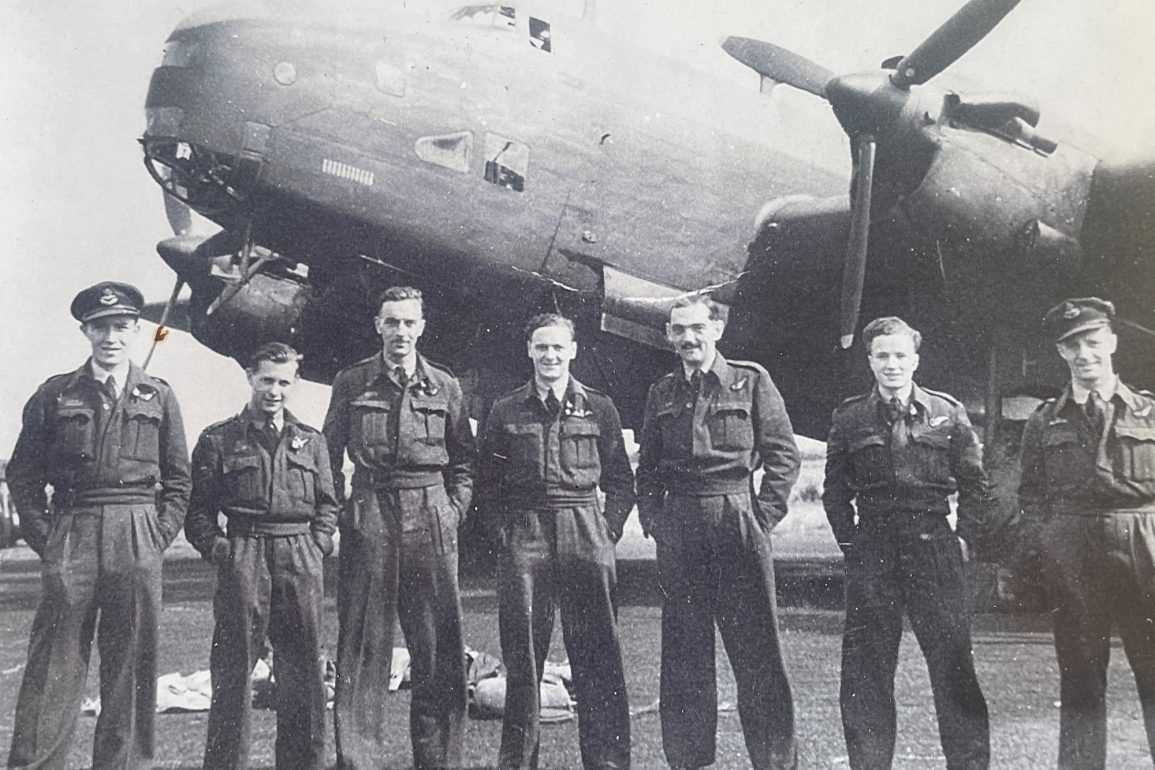The Spitfire and The Battle of Britain – As part of Airfix’s 70th anniversary (one of the world’s oldest and most well-known manufacturers of model kits), Airfix met with three wartime veterans, all of whom either flew or were in direct contact with Spitfires, to capture and share their incredible memories – their military journey and recollections of the aircraft.
RAF Bomber Command veteran George Dunn DFC L’dH. – age 100.
It wasn’t until the Battle of Britain took place that I ever thought about planes. The only thing I remember was when I was about 10 years old, Sir Alan Cobham’s Air Circus came to Whitstable where you could do a flight for 5 shillings. We couldn’t afford it, but it was the only time I had ever been in close contact with any aircraft.
Seeing his circus was a one-off. I didn’t think about flying until the war started.
When the war broke out, I was 17. A message was aired on the local radio calling for all people not due for call up, to report to the local police to join the local defence volunteers, so that’s what I did. All it did was give us an armband. No uniform, no weapons (eventually it became the Home Guard, and we got the uniforms and rifles!).
If you were call-up age, you could be put in any service – army, navy, or air force. I didn’t fancy either the army or the navy – I lived in Whitstable on the North Kent coast and saw quite a lot of the Battle of Britain. Being a youngster, I looked up at the sky and thought ‘I’ll have some of that!’. So, I went up to Chatham and I volunteered for aircrew.
I had volunteered to become a wireless operator air gunner because I’d left school at 14 and I wasn’t too sure that I would have enough qualifications to become a pilot. We had to do a little written exam and go before a selection board. They questioned my application to become an air gunner and, when I explained I didn’t think I had sufficient qualifications to become a pilot, they said, “we’ve had a look at your exam results, and we think you are, so would you consider changing it to pilot training?” – which of course I jumped at! That was January 1941. But I didn’t get called up until June of that year.
I went to Canada on a Norwegian troopship to do my flight training. I didn’t think I was even going to get to Canada – I was up at the camp in West Kirby, the Wirral and one night I was taken seriously ill with appendicitis and peritonitis. I was so bad that they said to my parents, they didn’t think I was going to make it! Luck would have it, I recovered. I had to go to RAF Holton for a medical; they put me on home service for six months which was rather disappointing as there was little pilot training in this country. Anyway, when I finally went back to West Kirby, I found myself on draft for Southern Rhodesia, so I told the officer in charge about my home service. I had to hang about there and went on to another camp at Heaton Park in Manchester. It’s now September time and all I’ve done is weeding and odd jobs. However, come Christmas 1941, I suddenly found myself on draft for Canada again, so I kept quiet and didn’t say anything. Right up until the time the ship sailed, I was on tenterhooks thinking they were going to come and pick me up and tell me I couldn’t go, but nothing happened. I got on the ship. Halfway through my training, I received a phone call from the medical officer to go and see him. He said to me “what are you doing out here”, I stayed shtum and said, “Sorry Sir, I don’t know what you’re talking about”. “Yes, you do!” he said and gave me an old-fashioned look. I said, “when you’re in the service you do what you’re told”. He sent me to Regina, Saskatchewan, and I had to go to a decompression chamber. When I came back, I had to have a full medical with him. But I passed and I was able to carry on.
The first time I flew I was in the far west of Canada. Our early flying was done in the snow. I hadn’t ever flown an aircraft before and unfortunately, my instructor wasn’t the patient type. If you weren’t doing things correctly then he would whip the stick out of your hand.
At one stage I thought I wouldn’t make it, but I managed to get a change of instructor. He was an ex-Battle of Britain pilot – a different type altogether – and I got on quite well with him. I got through the course with no trouble.
From Tiger Moths you could go onto twin-engine Ansons or single-engine Harvards. At that time, there was no question of where you were going to, or which command you were going to go into when you got back to the UK. That didn’t enter it at that stage.
When I came back to the UK, I did a short course on Airspeed Oxfords and then joined the Operational Training Unit (OTU) flying Wellingtons, and then the heavy commercial unit flying Halifax aircraft.
What were your parents’ thoughts on you volunteering to be a pilot?
During the war, my parents didn’t say very much. They knew their boy was putting his life in danger, flying operations into Germany every night. When I went on leave, they never asked me anything and I never told them, even after the war. That applied to many, many, aircrew – they didn’t talk about it to their parents.
Flying a Spitfire:
I didn’t fly the Spitfire in combat, I think I would have liked to have done it, even though I would be at risk.
My involvement with Spitfires was in some way quite accidental.
After the war, I was instructing on Wellingtons in Worksop, and they were asking for volunteers to fly Mosquitoes. I signed up with a Navigator and attended a Mosquito course. They asked volunteer crews to go out to Malta to form a Met [Meteorological] flight (at that time I was doing the same thing in the UK). They flew ten Mosquito crews out to Malta in a Stirling but when we arrived, believe it or not, they didn’t know what we were doing there. Can you imagine?! Ten crews and they didn’t know anything about us!
We appointed a spokesman who went to see the station commander, but he apologised and said, “I’m sorry we’ve got no information on you at all”. We hung around there for about six weeks just doing nothing. They didn’t really want to know us.
Eventually, they decided they weren’t going to form a Met flight after all, and we all got split up. I found myself in the canal zone in Egypt, in a place called Ismailia. It was a maintenance unit. I reported to the chief pilot and asked what he did there and told him my story about Malta. He said, “Oh! Well, we fly mostly Spitfires and now we’re mainly renovating them and selling them to the Greek air force”. I told him I hadn’t flown a single-engine aircraft since my Tiger Moth days. He said, “Oh you’ll be alright”, he slung the pilot’s notes across the table, “have a read-up of that”. Every aspect of the flying and the controls were in those notes: the fuel system, the hydraulics, the speeds, the height, and the emergency procedure. To be told I was going to fly a Spitfire was really something but, because dual-seater Spitfires didn’t exist in those days – it was just a single-seater – it was just a question of reading up those notes, getting in the plane and flying it.
I did most of my flying on a Mk IX. I went out on my first flight feeling a little bit apprehensive but once you’ve flown it doesn’t matter what type of aircraft is it, flying is much the same. It’s just a question of getting used to the controls of a different type of aircraft. I wasn’t scared or worried about the Spitfire. I started up and away we went. Once I was in the air, it was so different to flying what I was used to – heavy bombers like the Wellington and the Halifax. It was such a dominant aircraft; I know a lot of pilots who eventually flew them and always remember it from its activities in the Battle of Britain. It was far better, at one stage than anything the Germans had. It was so manoeuvrable. It was so light on the control and the speed and the rate of climb – everything was so easy and so light compared with aircraft I’d been used to flying. It was a great feeling to be flying in peacetime, to be up there on your own and be flying however you liked. It was a great experience.
To go into a Spitfire and throw it around the sky was an experience on its own.

After your RAF days:
When the war finished, I was in Egypt. My final flight in the RAF was bringing a Halifax back to the UK. At this time – 1947 – the airlines hadn’t really gotten going. There was only British European Airways, but there were so many pilots on the market. I went to the London School of Air Navigation to get my private pilot’s licence and in my lodging alone, there were 19 of us. For some months, I tried to get a job in flying but it was virtually impossible. So, I went back to the job I had before the war – working at Pickfords removal company. I was a branch manager at several places in the UK and stayed with them until I retired.
Why is the Spitfire synonymous with Britain?
The Spitfire was designed by R.J.Mitchell and was out of this world. I mean, we’d only been used to flying Gloster Gladiators. The Spitfire was a different cup of tea altogether – it had power, it had height and speed. Without the Spitfire and the Hurricane, I don’t know what would happen to this country. It was a one-off. It was a bit like the Mosquito later in the war – those two aircraft were phenomenal.
It made its name in the Battle of Britain. The Spitfire was the first. People saw it in action, and it was a remarkable aircraft because you could almost do what you like with it. It was so dominant in the Battle of Britain, and it just got to be known. Fortunately, since the war finished there are still several Spitfires around and people still revere them. It’s the one thing they remember from what went on in the war.
Can you remember how to fly?
Yes. I flew in a dual Spitfire three years ago and you don’t forget it. If anything had happened to the lead pilot while we were up there, I would have been quite confident in getting it back down to earth. It’s just a question of remembering the controls. The basics of flying you don’t lose.
Did you used to do any modelling during your downtime in the war?
I didn’t personally make models during my downtime, but I know that some of the ground crew did. I also know there were prisoners of war who’d make models of anything to keep them occupied. They make it out of wood or metal – whatever was available.
Your thoughts on modelling today and Airfix?
The youngsters of today are far more adept at understanding models than they were years ago. Tanks, aircraft, cars – you name it. Youngsters are really interested in making them up and doing that will only encourage them to think further on in other ways. That building a model aircraft may lead to them saying “I like that. I hope one day I can fly it”.
Poppy Watt


